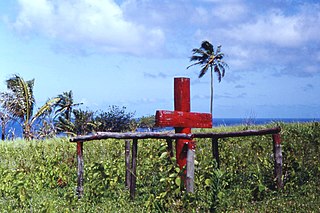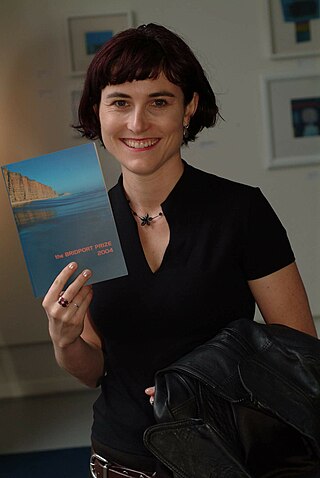
Melanesia is a subregion of Oceania in the southwestern Pacific Ocean. It extends from New Guinea in the west to the Fiji Islands in the east, and includes the Arafura Sea.

A cargo cult is a Melanesian indigenist millenarian belief system in which a group of people in an indigenous society imitate the behaviors, rituals, and symbols associated with technologically advanced societies, particularly those characterized by transportation and material wealth, in the apparent hope of attracting similar benefits. The term "cargo cult" was introduced to the field of anthropology during and after World War II. More recent scholarship on cargo cults has challenged the suitability of the term for the movements associated with it, with some critics arguing that the term is borne of prejudice and does not accurately convey the nature of the movements to which it refers.

Pacific Islanders, Pasifika, Pasefika, Pacificans or rarely Pacificers are the peoples of the Pacific Islands. As an ethnic/racial term, it is used to describe the original peoples—inhabitants and diasporas—of any of the three major subregions of Oceania.
Polynesians form an ethnolinguistic group of closely related people who are native to Polynesia, an expansive region of Oceania in the Pacific Ocean. They trace their early prehistoric origins to Island Southeast Asia and form part of the larger Austronesian ethnolinguistic group with an Urheimat in Taiwan. They speak the Polynesian languages, a branch of the Oceanic subfamily of the Austronesian language family. The Indigenous Māori people constitute the largest Polynesian population, followed by Samoans, Native Hawaiians, Tahitians, Tongans and Cook Islands Māori

Near Oceania is the part of Oceania settled 35,000 years ago, comprising Australia, New Guinea, and north-western Island Melanesia: the Bismarck Archipelago and the Solomon Islands.

Melanesians are the predominant and indigenous inhabitants of Melanesia, in an area stretching from New Guinea to the Fiji Islands. Most speak one of the many languages of the Austronesian language family or one of the many unrelated families of Papuan languages. There are several creoles of the region, such as Tok Pisin, Hiri Motu, Solomon Islands Pijin, Bislama, and Papuan Malay.

Polynesian outliers are a number of culturally Polynesian societies that geographically lie outside the main region of Polynesian influence, known as the Polynesian Triangle; instead, Polynesian outliers are scattered in the two other Pacific subregions: Melanesia and Micronesia. Based on archaeological and linguistic analysis, these islands are considered to have been colonized by seafaring Polynesians, mostly from the area of Tonga, Samoa and Tuvalu.

Tikopia is a volcanic island in the southwestern Pacific Ocean. It forms a part of the Melanesian nation state of Solomon Islands but is culturally Polynesian. The first Europeans arrived on 22 April 1606 as part of the Spanish expedition of Pedro Fernandes de Queirós.

The Anglican Church of Melanesia (ACoM), also known as the Church of the Province of Melanesia and the Church of Melanesia (COM), is a church of the Anglican Communion and includes nine dioceses in the Solomon Islands, Vanuatu and New Caledonia. The Archbishop of Melanesia is Leonard Dawea. He succeeds the retired archbishop George Takeli.

Melanesian mythology refers to the folklore, myths, and religions of Melanesia, a region in Southwest Oceania that encompasses the archipelagos of New Guinea, the Torres Strait Islands, Solomon Islands, Vanuatu, New Caledonia and Fiji. The various mythologies consist primarily of the traditions of oral literature in the different populations of Melanesia. More recent aspects include the cargo cults born in the 20th century during the Pacific War.

Southern Cross is the name given to each of a succession of ships serving the Melanesian Mission of the Anglican Church and the Church of the Province of Melanesia. The first ship having this name succeeded the Undine, a 21-ton schooner built at Auckland and in service from 1849 to 1857.
The Archbishop of Melanesia is the spiritual head of the Church of the Province of Melanesia, which is a province of the Anglican Communion in the South Pacific region, covering the nations of Solomon Islands and Vanuatu. From 1861 until the inauguration of Church of the Province of Melanesia in 1975, the Bishop of Melanesia was the head of the Diocese of Melanesia.

Polynesia is a subregion of Oceania, made up of more than 1,000 islands scattered over the central and southern Pacific Ocean. The indigenous people who inhabit the islands of Polynesia are called Polynesians. They have many things in common, including language relatedness, cultural practices, and traditional beliefs. In centuries past, they had a strong shared tradition of sailing and using stars to navigate at night. The largest country in Polynesia is New Zealand.

Honiara is the capital and largest city of Solomon Islands, situated on the northwestern coast of Guadalcanal. As of 2021, it had a population of 92,344 people. The city is served by Honiara International Airport and the seaport of Point Cruz, and lies along the Kukum Highway.
Erenora Puketapu-Hetet was a noted New Zealand weaver and author. A key figure in the Māori cultural renaissance, she helped change perceptions of Māori weaving/raranga from craft to internationally recognized art.

Laura Jane Solomon was a New Zealand novelist, playwright and poet. She emerged as part of a new wave of young New Zealand writers in the 1990s anthologised in Mark Pirie's New Zealand Writing: The NeXt Wave (1998). Her first two novels were published around this time, while Solomon was in her early 20s, and she subsequently moved abroad to London where she wrote further works and trained as an IT professional. In 2007 she returned to New Zealand due to ongoing health problems, but continued to write and publish prolifically until her death. Solomon is best-known as a novelist, but her poetry and short stories have also been widely published and short-listed for awards and prizes.

Nina Nawalowalo is a New Zealand theatre director and co-founder of the contemporary Pacific theatre company The Conch. She is known for directing the stage plays Vula and The White Guitar. The first film she directed A Boy Called Piano - The Story of Fa'amoana John Luafutu (2021) won 2022 Montreal Independent Film Festival Best Feature Documentary.
The 2013 New Year Honours in New Zealand were appointments by Elizabeth II in her right as Queen of New Zealand, on the advice of the New Zealand government, to various orders and honours to reward and highlight good works by New Zealanders, and to celebrate the passing of 2012 and the beginning of 2013. They were announced on 31 December 2012.

The civilian population, culture and infrastructure of Melanesia, Micronesia and Polynesia were completely changed between 1941 and 1945 because of the logistical requirements of the Allies in their war against Japan. At the start of the war some of the islands had experienced up to 200 years of colonialism from Europe and its colonies, some on the verge of being fully annexed, others close to independence. The early Japanese expansion through the western Pacific then introduced a new colonial system to many islands. The Japanese occupation subjected the indigenous people of Guam and other Pacific Islands to forced labor, family separation, incarceration, execution, concentration camps, and forced prostitution.
The 2022 New Year Honours in New Zealand were appointments by Elizabeth II in her right as Queen of New Zealand, on the advice of the New Zealand government, to various orders and honours to reward and highlight good works by New Zealanders, and to celebrate the passing of 2021 and the beginning of 2022. They were announced on 31 December 2021.













